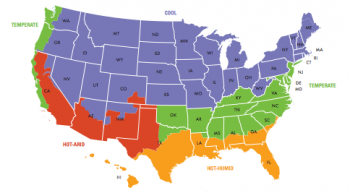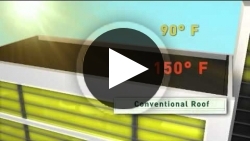
This map shows the four broadest categories of climate zones for the lower 49 United States. Understanding your climate zone can help you determine the best energy-saving landscaping strategies for your home.
A well-designed landscape not only can add beauty to your home but also can reduce your heating and cooling costs. A well-placed tree, shrub, or vine can deliver effective shade, act as a windbreak, and reduce your energy bills. Carefully positioned trees can save up to 25% of the energy a typical household uses. Check out our Energy Saver 101 infographic for more ways your landscaping can help you save energy and water.
Climate
The energy-conserving landscape strategies you use depends on where you live. The United States can be divided roughly into four climate regions -- temperate, hot-arid, hot-humid, and cool. See the map to find your climatic region. Below you'll find landscaping strategies listed by region and in order of importance.
Temperate Region
- Maximize warming effects of the sun in the winter.
- Maximize shade during the summer.
- Deflect winter winds away from buildings with windbreaks of trees and shrubs on the north and northwest side of the house.
- Tunnel summer breezes toward the home.
Hot-Arid Region
- Provide shade to cool roofs, walls, and windows.
- Allow summer winds to access naturally cooled homes.
- Block or deflect winds away from air-conditioned homes.
Hot-Humid Region
- Channel summer breezes toward the home.
- Maximize summer shade with trees that still allow penetration of low-angle winter sun.
- Avoid locating planting beds close to the home if they require frequent watering.
Cool Region
- Use dense windbreaks to protect the home from cold winter winds.
- Allow the winter sun to reach south-facing windows.
- Shade south and west windows and walls from the direct summer sun, if summer overheating is a problem.
Microclimate
The climate immediately surrounding your home is called its microclimate. When landscaping for energy efficiency, it's important to consider your microclimate as well as your regional climate.
Your home's microclimate may receive more sun, shade, wind, rain, snow, moisture, and/or dryness than average local conditions. If your home is located on a sunny southern slope, for example, it may have a warm microclimate, even if you live in a cool region. Or, even though you live in a hot-humid region, your home may be situated in a comfortable microclimate because of abundant shade and dry breezes. Nearby bodies of water may increase your site's humidity or decrease its air temperature. Microclimatic factors also help determine what plants may or may not grow in your landscape.



